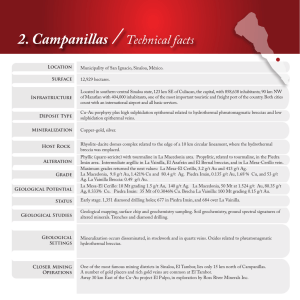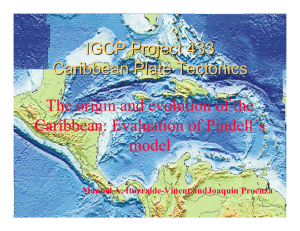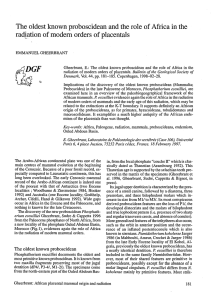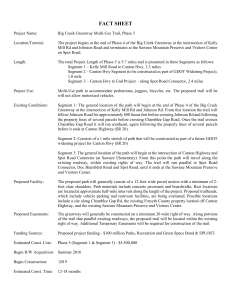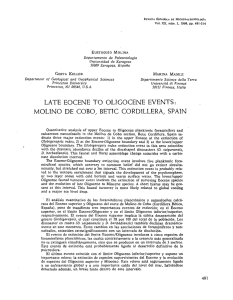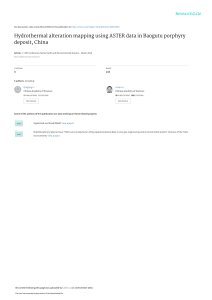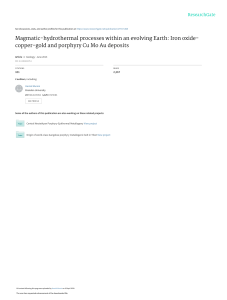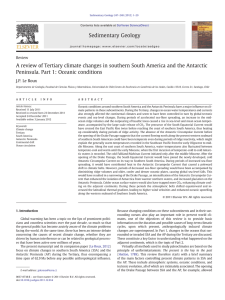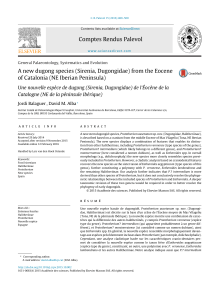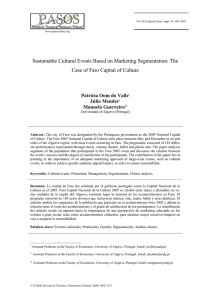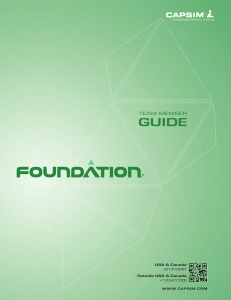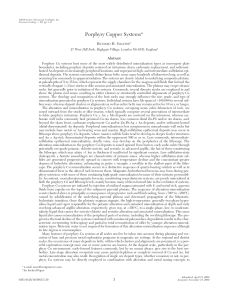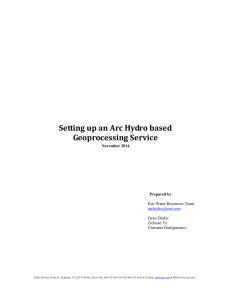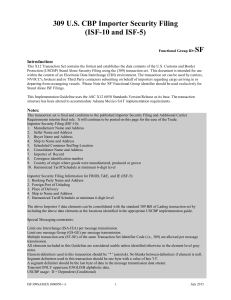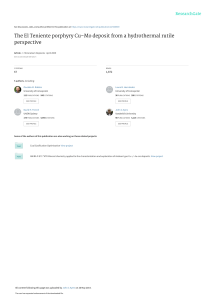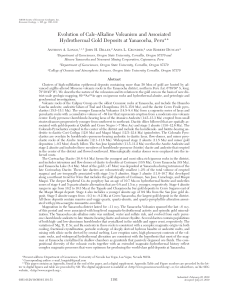Porphyry Copper Metallogenesis Along the Middle Eocene
Anuncio
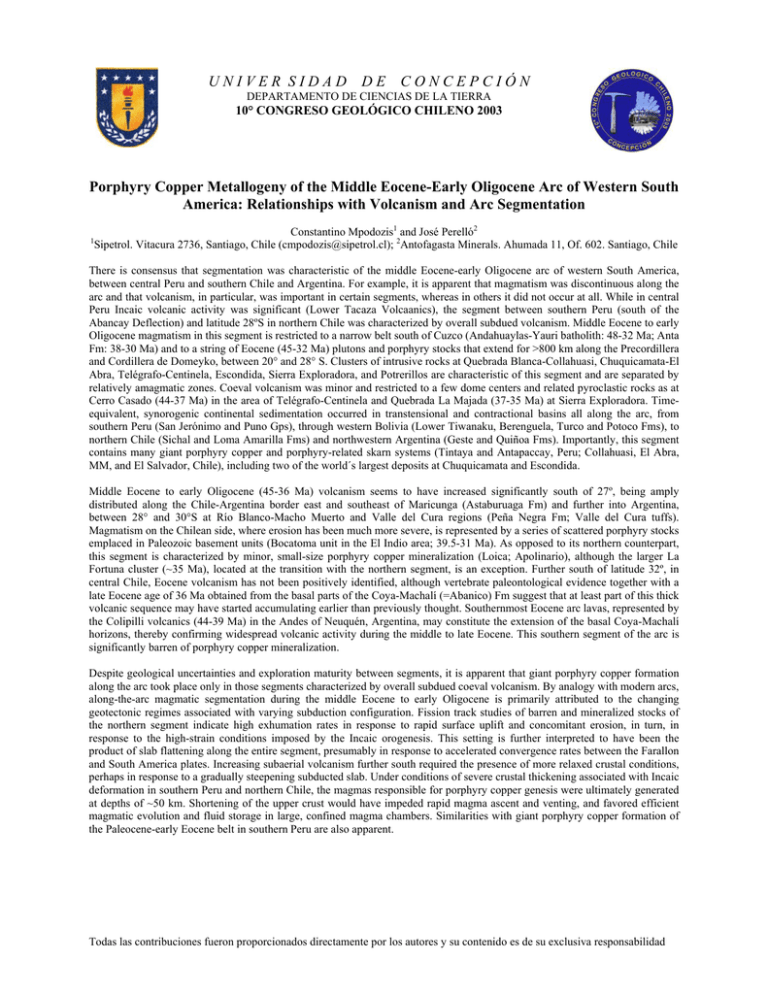
UNIVER SIDAD DE CONCEPCIÓN DEPARTAMENTO DE CIENCIAS DE LA TIERRA 10° CONGRESO GEOLÓGICO CHILENO 2003 Porphyry Copper Metallogeny of the Middle Eocene-Early Oligocene Arc of Western South America: Relationships with Volcanism and Arc Segmentation Constantino Mpodozis1 and José Perelló2 Sipetrol. Vitacura 2736, Santiago, Chile ([email protected]); 2Antofagasta Minerals. Ahumada 11, Of. 602. Santiago, Chile 1 There is consensus that segmentation was characteristic of the middle Eocene-early Oligocene arc of western South America, between central Peru and southern Chile and Argentina. For example, it is apparent that magmatism was discontinuous along the arc and that volcanism, in particular, was important in certain segments, whereas in others it did not occur at all. While in central Peru Incaic volcanic activity was significant (Lower Tacaza Volcaanics), the segment between southern Peru (south of the Abancay Deflection) and latitude 28ºS in northern Chile was characterized by overall subdued volcanism. Middle Eocene to early Oligocene magmatism in this segment is restricted to a narrow belt south of Cuzco (Andahuaylas-Yauri batholith: 48-32 Ma; Anta Fm: 38-30 Ma) and to a string of Eocene (45-32 Ma) plutons and porphyry stocks that extend for >800 km along the Precordillera and Cordillera de Domeyko, between 20° and 28° S. Clusters of intrusive rocks at Quebrada Blanca-Collahuasi, Chuquicamata-El Abra, Telégrafo-Centinela, Escondida, Sierra Exploradora, and Potrerillos are characteristic of this segment and are separated by relatively amagmatic zones. Coeval volcanism was minor and restricted to a few dome centers and related pyroclastic rocks as at Cerro Casado (44-37 Ma) in the area of Telégrafo-Centinela and Quebrada La Majada (37-35 Ma) at Sierra Exploradora. Timeequivalent, synorogenic continental sedimentation occurred in transtensional and contractional basins all along the arc, from southern Peru (San Jerónimo and Puno Gps), through western Bolivia (Lower Tiwanaku, Berenguela, Turco and Potoco Fms), to northern Chile (Sichal and Loma Amarilla Fms) and northwestern Argentina (Geste and Quiñoa Fms). Importantly, this segment contains many giant porphyry copper and porphyry-related skarn systems (Tintaya and Antapaccay, Peru; Collahuasi, El Abra, MM, and El Salvador, Chile), including two of the world´s largest deposits at Chuquicamata and Escondida. Middle Eocene to early Oligocene (45-36 Ma) volcanism seems to have increased significantly south of 27º, being amply distributed along the Chile-Argentina border east and southeast of Maricunga (Astaburuaga Fm) and further into Argentina, between 28° and 30°S at Río Blanco-Macho Muerto and Valle del Cura regions (Peña Negra Fm; Valle del Cura tuffs). Magmatism on the Chilean side, where erosion has been much more severe, is represented by a series of scattered porphyry stocks emplaced in Paleozoic basement units (Bocatoma unit in the El Indio area; 39.5-31 Ma). As opposed to its northern counterpart, this segment is characterized by minor, small-size porphyry copper mineralization (Loica; Apolinario), although the larger La Fortuna cluster (~35 Ma), located at the transition with the northern segment, is an exception. Further south of latitude 32º, in central Chile, Eocene volcanism has not been positively identified, although vertebrate paleontological evidence together with a late Eocene age of 36 Ma obtained from the basal parts of the Coya-Machalí (=Abanico) Fm suggest that at least part of this thick volcanic sequence may have started accumulating earlier than previously thought. Southernmost Eocene arc lavas, represented by the Colipilli volcanics (44-39 Ma) in the Andes of Neuquén, Argentina, may constitute the extension of the basal Coya-Machalí horizons, thereby confirming widespread volcanic activity during the middle to late Eocene. This southern segment of the arc is significantly barren of porphyry copper mineralization. Despite geological uncertainties and exploration maturity between segments, it is apparent that giant porphyry copper formation along the arc took place only in those segments characterized by overall subdued coeval volcanism. By analogy with modern arcs, along-the-arc magmatic segmentation during the middle Eocene to early Oligocene is primarily attributed to the changing geotectonic regimes associated with varying subduction configuration. Fission track studies of barren and mineralized stocks of the northern segment indicate high exhumation rates in response to rapid surface uplift and concomitant erosion, in turn, in response to the high-strain conditions imposed by the Incaic orogenesis. This setting is further interpreted to have been the product of slab flattening along the entire segment, presumably in response to accelerated convergence rates between the Farallon and South America plates. Increasing subaerial volcanism further south required the presence of more relaxed crustal conditions, perhaps in response to a gradually steepening subducted slab. Under conditions of severe crustal thickening associated with Incaic deformation in southern Peru and northern Chile, the magmas responsible for porphyry copper genesis were ultimately generated at depths of ~50 km. Shortening of the upper crust would have impeded rapid magma ascent and venting, and favored efficient magmatic evolution and fluid storage in large, confined magma chambers. Similarities with giant porphyry copper formation of the Paleocene-early Eocene belt in southern Peru are also apparent. Todas las contribuciones fueron proporcionados directamente por los autores y su contenido es de su exclusiva responsabilidad

